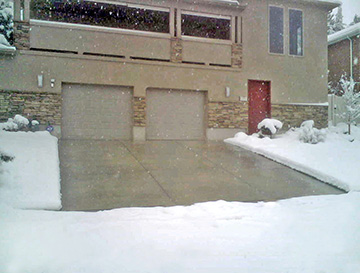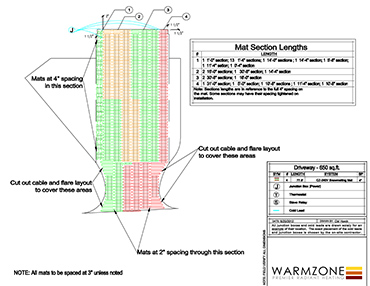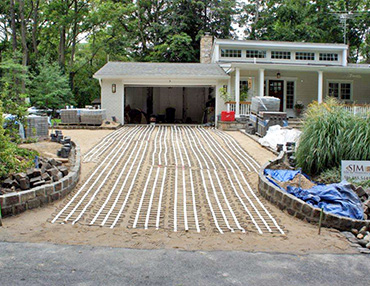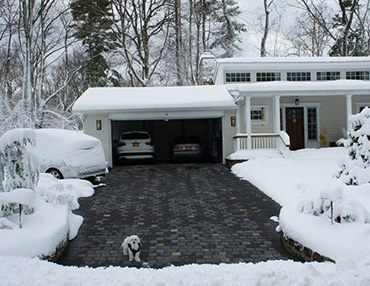Heated Driveways
What You Should Know About Radiant Snow Melting Systems

Overview of Topics:
- • A Brief History of Radiant Heat
- • Overview of Basic Components and How Snow Melting Systems are Installed
- • How do Heated Driveways Work?
- • How to Calculate the Operating Costs of a Heated Driveway
- • What to Look for When Purchasing a Radiant Heat System
- • Comparing Heated Driveway Systems
A Brief History of Radiant Heat
Believe it or not, the beginnings of heated driveway systems began centuries ago. Although radiant heat
is perceived to be a relatively new heating technology, in fact, radiant heat was used thousands of
years ago. While evidence points to civilizations in Asia using radiant heat 10,000 years ago, it was the
ancient Romans who refined the technology (circa 500 B.C.), creating an under floor heating system called a
“hypocaust”. A series of tiled pillars, roughly 2-feet high, supported the slab floor. Spaces were also
created inside the walls of the building. A wood-fired furnace was located at the outside of the
building and placed below the floor level. Heat from the furnace rose into the space below the floor and
rose up through, and eventually out of the walls, spreading warmth as it travelled through the structure. The
system worked surprisingly well, provided there was someone continually feeding the furnace with wood.
In the 1980s, the first standards for floor heating systems were developed in Europe. During this decade,
radiant floor heating became the traditional heating system for residential buildings in Middle Europe
and Nordic countries, as well as several countries in Asia. Eventually, western countries embraced radiant
heat, utilizing hydronic (water-based) and electric technologies. Today, heated driveways and
floor heating systems are rapidly gaining popularity throughout Northern America.

Warmzone design/layout of heated paver driveway.

ClearZone heating mats rolled out over paver dust.

The completed heated driveway with brick pavers.
System Components and Overview of How Snow Melting Systems are Installed
Heated driveways utilize a heating element (heat cable), an aerial-mount or ground-mount activation device (snow sensor)
and contactor panel / controller. Electric snow melting systems use twin-conductor, resistance heat cable that is ideally embedded about
2-inches below the driveway's surface. The cold leads of the heat cable are then run to the contactor panel, which is
typically installed on the wall in the garage. (For more information about the benefits of radiant snow melting systems, visit our
Heated Driveway Benefits
web page.) The cable can be installed under pavers, in concrete and even in hot asphalt applications.
Most residential heated driveway systems feature an aerial-mount snow sensor that is typically installed at the roof's edge,
just above the roof line. The device has temperature and precipitation sensors, so the automated system operates only when
needed. When the in-ground activation device is used, it is used in conjunction the small Warmzone snowmelt control unit.
This NEMA 1 wall-mount control panel is approximately 6x3.5 inches and is designed to also be controlled from an external
signal (day/week timer, GSM-module or other signal source). The compact controller can be switched on/off (standby) and the
snow melting system can be manually turned on in case wind causes snow drifts or ice forms in the shade. Read more about
INSTALLING A HEATED DRIVEWAY.
How do Heated Driveways Work?
The activation device (snow sensor) has an adjustable temperature set point. When the sensor detects moisture and
the temperature is below the set point (usually set at 39° Fahrenheit), it signals the contactor panel to send power
to the embedded heat cable. The surface quickly warms and prevents the accumulation of snow. The system remains on
for a short time after the snow stops falling to dry the surface of the driveway, preventing ice from forming.
Then the snow melting system shuts off. Warmzone driveway heating systems also include manual override capability to melt
snow drifts that may have formed due to wind or to preheat an area before a large storm to better prevent snow and ice
accumulation. Read more about
HOW HEATED DRIVEWAYS WORK.
How to Calculate the Operating Costs of an Electric Heated Driveway
Like snowflakes, no two radiant driveway heating systems are exactly alike. Each system is designed according to
the specifics of the project, such as the average temperature and snowfall associated with the location of the system.
The system is also designed in accordance with the available power and homeowner's budget.
To determine the general operating costs of a heated driveway, use the formula below to calculate what your costs
would be.
| 1. | Determine the total square footage of the area that will be heated. |
| 2. | Multiply the square footage by the heat required (37 watts per square foot for residential properties). This gives you a total for the watts per square footage required. |
| 3. | Divide this number by 1,000 to convert to kilowatts. |
| 4. | Look up the kilowatts-per-hour rate from the local power utility company. |
| 5. | Multiply the total watts-per-square footage by the watts-per-hour. This gives you the cost-per-hour of usage for the snow melting system. |
| 6. | NOTE: Heating cables and mats are rated in total watts. If the snowmelt system is intended for a commercial application, then you would multiply the total square footage by 50 watts to get a total wattage required. (E.g., 5,000 sq. ft. x 50 watts = 250,000 watts required.) |
What to Look for When Shopping for a Radiant Heated Driveway System
There are many radiant heat providers offering snow melting solutions, but the products and services can vary greatly.
So what do you look for? How do you know if one system is better than another?
First of all, one of the most
important things for you to know is that a radiant heating system is only as good as its installation. So if you're serious
about finding the best system for the best price, you'll want more than proven products. You'll want a provider that backs
up its products and includes premier system design, training, and support services. Most reputable radiant heat providers
offer snow melting systems with a warranty of 10 years. Check out the "shopping" list below:
What to Look for in a Snow Melting System
There are many radiant heat providers offering snow melting solutions, but they are not created equal. Be sure to check for the following:
Comparing Heated Driveway Systems
The best heated driveway is not necessarily a specific brand, but one that has been custom designed
to best meet your specific snow melting needs. Certainly there are top quality heating elements and system
components that you'll want to use, but the design and installation of the system is what's most critical.
Reputable radiant heat providers will work closely with you and take several factors into consideration
when designing a driveway heating system. Information necessary to design a system for your home or
business includes: location and elevation, average winter climate, power requirements of the system
and power availability, and of course, your budget. These are some of the factors used to determine
the system that will be the most effective for heating your driveway and/or walkways.
Simply put, the best heated driveway is the one that not only features the top products, but is efficiently
tailored to perform ideally under the conditions that are unique to your demands. In other words, the best heated driveway system
for a homeowner in Fargo, North Dakota is going to differ from a system designed to heat a driveway in Tehachapi,
California. Experienced radiant heat providers will carefully evaluate your snow melting needs before
recommending and designing a driveway heating solution. (Beware of radiant heat providers that recommend
a solution before learning about your specific snowmelt needs.)
